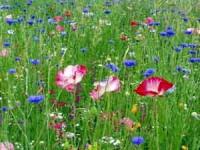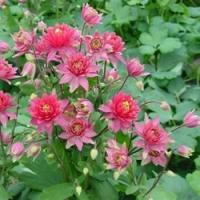Plant Wild Flowers To Attract Small Insects That Are So Important For Our Eco System
Having wild flowers in the garden has a most attractive appeal. One thinks of long tramps in the woods, collecting seeds and plants, introducing them into your own garden as somewhere to attract all sorts of wildlife.
Caution should be taken when looking for flowers in the wild, as local bylaws may forbid this. Due dilgence should be carried out before jumping right in.
Many wild plants are on the verge of extinction because people have taken them illegally.
Of course it is far better and easier to purchase wild flower seeds from a nursery, and you will probably have a greater degree of success, as even wild flowers do not appreciate being moved from their natural habitat.
The Fact Is...
Wildflowers help support entire eco-systems for pollinators, birds, and small animals. Butterflies and other insects, small birds, and animals depend on seeds, nectar, and pollen for their food supply. Indeed many gardeners set up areas exclusively for Butterflies, hence a Butteryfly Garden.
The bed into which these wild flowers plants are to go should be prepared carefully before hand. You do not want to bring plants home and then to wait a couple of days before planting. They should go into new quarters at once.
The bed needs soil that is, deep and rich and full of leaf mold and the under drainage system should be good. A lot of people assume that all wood plants should have a soil saturated with water but that is misleading.
It may be that you will need to dig your garden deeply and put some stone in the bottom cover with soil, and on the top, where the top soil once was, put a new layer of the rich soil.
Planning...
It would be a good idea to have a plan to have your wild flower garden giving a succession of bloom from early spring to late fall. so let us start off with March, the hepatica, spring beauty and saxifrage.
Then comes April bearing in its arms the beautiful columbine, the tiny bluets and wild geranium. For May there are the dog-tooth violet and the wood anemone, false Solomon's seal, Jack-in-the-pulpit, wake robin, bloodroot and violets.
June will give the bellflower, mullein, bee balm and foxglove. I would choose the gay butterfly weed for July. Let turtle head, aster, Joe Pye weed, and Queen Anne's lace make the rest of the season brilliant until frost.
Is there anyone who doesn't love the hepatica?
Before the spring has really decided to come, this little flower pokes its head up and puts all else to shame. Tucked under a covering of dry leaves the blossoms wait for a ray of warm sunshine to bring them out. These embryo flowers are further protected by a fuzzy covering.
This reminds one of a similar protective covering which new fern leaves have. In the spring a hepatica plant wastes no time on getting a new suit of leaves. It makes its old ones do until the blossom has had its day. Then the new leaves, started to be sure before this, have a chance. These delayed, are ready to help out next season.
You will find hepaticas growing in clusters, sort of family groups. They are likely to be found in rather open places in the woods. The soil is found to be rich and loose. So these should go only in partly shaded places and under good soil conditions.
If planted with other wood specimens give them the benefit of a rather exposed position, that they may catch the early spring sunshine. I should cover hepaticas over with a light litter of leaves in the fall. During the last days of February, unless the weather is extreme take this leaf covering away. You'll find the hepatica blossoms all ready to poke up their heads.
The spring beauty hardly allows the hepatica to get ahead of her. With a white flower which has dainty tracings of pink, a thin, wiry stem, and narrow, grass-like leaves, this spring flower cannot be mistaken. You will find spring beauties growing in great patches in rather open places.
The other March flower mentioned is the saxifrage. This belongs in quite a different sort of environment. It is a plant which grows in dry and rocky places. Often one will find it in chinks of rock.
There is an old tale to the effect that the saxifrage roots twine about rocks and work their way into them so that the rock itself splits. Anyway, it is a rock garden plant. I have found it in dry, sandy places right on the borders of a big rock
Columbine...
The columbine is another plant that is quite likely to be found in rocky places. Standing below a ledge and looking up, one sees nestled here and there in rocky crevices one plant or more of columbine. The nodding red heads bob on wiry, slender stems. The roots do not strike deeply into the soil; in fact, often the soil hardly covers them.
Now, just because the columbine has little soil, it does not signify that it is indifferent to the soil conditions. For it always has lived, and always should live, under good drainage conditions. I wonder if it has struck you, how really hygienic plants are? Plenty of fresh air, proper drainage, and good food are fundamentals with plants.
It is evident from studying these wild flowers just how easy it is to determine what plants like. After studying their requirements do not make the mistake of huddling them all together under poor drainage conditions.
Columbine - Clementine Red...
Columbine Clementine Red, Aquilegia vulgaris 'Clementine Red', is part of a spectacular new generation of Columbine, with flowers resembling a small double flowering Clematis. The fuchsia-red flowers of Aquilegia 'Clementine Red' are fully double and spurless. Butterflies and hummingbirds love the intense color!
The upward facing flowers also make excellent cut flowers. The plant habit is perfectly upright and the foliage is attractive even when the plants are not in bloom. In late spring and early summer, they produce picture perfect bouquets of flowers just above the mounded foliage. Resistant to both deer and rabbits. 'Clementine Red' is easily grown in average, medium, well-drained soil in full sun to part shade.
Tolerates wide range of soils except heavy, poorly drained ones. Prefers rich, moist soils with light to moderate shade. Remove flowering stems after bloom to encourage additional bloom. Keep soils uniformly moist after bloom to prolong attractive foliage appearance. When foliage depreciates, plants may be cut to the ground.
Seventeen Wild Flower Seed Varieties In One Packet
These Instant Flower Mixtures put the fun back into flower gardening. Sun and Shade Wildflower mix contains 17 species of annual and perennial wild flowers designed to grow in partial shade or full sun. These attractive flowers are designed to grow well in almost any area in the U.S. and Canada

This mixture contains approximately 85,000 seeds and will cover 750 square feet. The seed varieties included are Chinese Forget Me Knot, Bachelor Button, Sweet William, Coreopsis, Rocket Larkspur, Baby’s Breath, Baby Blue Eyes, Sweet Alyssum, Shasta Daisy, Purple Coneflower, Five Spot, Candytuff, Corn Poppy, Clarkia, Spurred Snapdragon Northern Lights, Foxglove and Garden Columbine.
The premium wildflower seed is pre-mixed with ground coir, fertilizer and Moisture Boost Plus crystals. This combination produces a sterile seed bed that absorbs and retains moisture. Just add water, and the mixture will expand to 4 pounds of easy-to-sow wildflower growth medium
Gardening Tools › Flower gardening › Wild Flowers









New! Comments
Have your say about what you just read! Leave me a comment in the box below.